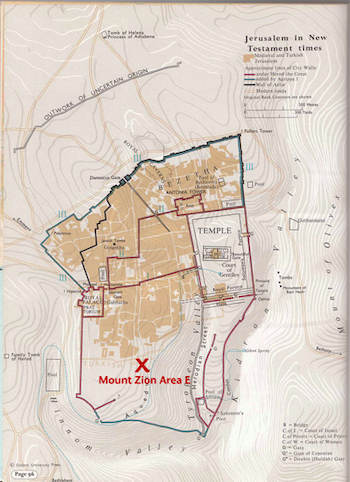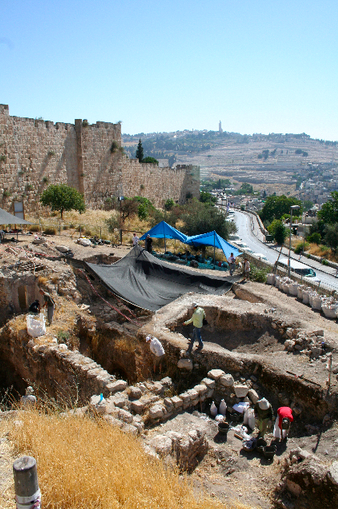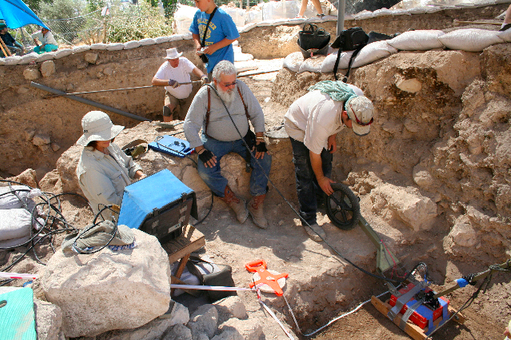The 2009 Season: June 14-July 24
By Shimon Gibson and James D. Tabor

Location of the Mt Zion Dig on a Map of Herodian Jerusalem
A second season of digging was made this year at the Mount Zion (Ayyubid Gate) site between 8th June and 24th July 2008. The team consisted of Shimon Gibson and James Tabor (Project Directors), Rafi Lewis (Field Director), Mareike Grosser (Site Manager), and Yusuf (foreman). Warren C. Schultz (DePaul University) was in charge of numismatics and participated in the excavations as well. Additional consultants included Ram Bouchnik (archaeozoology) and Eric C. Lapp (lamps). The ground-penetrating radar work was conducted by the Pinchus family.The excavation is being conducted on behalf of the University of North Carolina at Charlotte. There are a number of sponsors including the Guttman Foundation and Sheila Bishop and The Foundation for Biblical Archaeology. Licenses for the work were received from the Israel Antiquities Authority (G-12/2008) and the Israel Parks Authority (1673/08). There were numerous visits to the site by archaeological colleagues, among them Tsvika Tzuk, Jodi Magness, Hillel Geva, Meir Ben Dov, Ephraim Stern, Robert Kool, and others. We are grateful for their support and enthusiasm.

Mt Zion Staff: Mareike Grosser, Rafi Lewis, Shimon Gibson, James Tabor
Excavations – Week One (15th – 20th June 2008)
The summer season actually began on 8th June with the removal of a number of dangerous earthen walls (baulks) from Broshi’s excavations of the 1970s on the western side of the area. Before the arrival of the first group of team members, work was conducted by Yusuf with archaeological supervision. The work with the team members began on 15th June with a general cleaning of the site, with the removal of vegetation and garbage. This was tough work, but it had to be done. Digging concentrated during the first week in Field H with work following on directly from that previously made in the March season. It was decided to dismantle one of the walls in this area (W226) after recording it in drawings and photography since it seemed to be a later addition to the main wall (W190). Within the matrix of the wall were two coins and a polished bone implement fragment. We also sought to find the extension of W190 to the south with some success. To the west, we decided to remove the modern garden fill (L133) so as to attempt clarification for the stratigraphy of the area excavated last March and the area that was excavated nearby in the 2000 season. This revealed the ashlars from the Ayyubid tower that were pushed here in the early 1980s when the Jerusalem municipality decided to establish a path with steps next to the Old City wall. In Field F, immediately to the south-west of Field H, we began clearing away a fill (L161) which seemed to precede the modern activities in the area connected with the construction of the adjacent modern street. We also renewed the excavation of an area previously dug in 2000 which had a layer packed with pottery from the Second Temple period (L229), including metal fragments, nails, and a coin, stone vessels, and lamp fragments.

Overview of the Excavation Area at the end of 2008 Season
Excavations – Week Two (22nd – 27th June 2008)
The team members began settling down to the job of excavating the various features during the second week of digging. This week certain wall stubs in Field H were removed, revealing a variety of features below them: foundation trenches, walls with a different orientation (e.g., W239), and packed consolidation walls and pits. Very confusing, but each feature needed to be carefully excavated and recorded. The material from every dismantled feature was also sieved which slowed down the work, but the finding of coins and other small finds showed that it was worthwhile. The amount of stones and rubble in all directions was bewildering, and we began appreciating the difficulties Kenyon had with her own work in Jerusalem in the 1960s with trying to keep straight sections with so many stones around. In the area to the west, we found what seemed to be a terrace wall (W235) of Abbasid or Fatimid date, just below the Ayyubid cistern, and below it a floor with the negative of a robbed-out wall (L245) with a coin mixed with its backfill. On the floor were polished bone implements and coins. Locus 229 continued to provide vast quantities of Second Temple (first century) pottery, with the occasional special find, such as an iron nail and a carbonized olive pit. The foundation trench with packed stones around the cistern opening in this area was kept as a distinct area and separated from the fill of L229. Cleaning and clarification of the various fills and debris layers in the various parts of the dig continued. A tile stamped by the Roman Tenth Legion was also found.
Excavations – Week Three (29th June – 4th July)
A new group of team members joined us for this two-week period. A new wall appeared in Field H (W258) which seemed to have another wall (W238) abutting it from the north. Field H continued to be characterized by rubble layers, multiple foundation trenches, and consolidation layers. The wall beneath W190 which was labeled W238 was also removed this week. A number of beads were found, as well as the base of a large stone vase (qalal) from the first century. A robber’s trench (L259) for a corner of an Umayyad wall appeared in the area on the southwest, and a coin was found in its backfill. Within this wall was a mosaic floor with simple black-and-red floret decorations and with a circular sump in the corner. We also extended the area even further to the southwest to join up with an area excavated by Broshi in the 1970s. This area had large quantities of modern rubbish in it, but we carefully separated the layers as individual loci. Eventually we got down to the stone and mortar base of a mosaic floor (L276) that Broshi apparently uncovered in the 1970s. Coins continued emerging in the different parts of the excavation.

Excavation area looking East toward the Mt of Olives
Excavations – Week Four (6th – 11th July)
In the area outside the robbed-out wall surrounding the mosaic floor fragment, we came across a thick layer of yellow-brown fill with Abbasid pottery and fragments of black platters with incised decorations on their exteriors. There was also an iron knife handle on a segment of plastered floor. An interesting square plaster box-like depression was found next to the mosaic floor and to its west. In the area of Broshi’s trench we descended to quite a depth, finding modern plastic bags all the way down mixed with a tumble of well-dressed stones, to what appears to be the top of an ancient wall. The depth of the deposits here meant that we had to cease work until next year when we could remove some of the dangerous adjacent garden fills. In Field H, we continued descending through the Second Temple fills (L249) on the west side of the wall and foundation features, as well as through the fills on the north side as well (L282). It became clear that the wall features we had excavated in association with the mosaic floor fragments were of Umayyad date, whereas there were wall foundations of Byzantine date beneath the underlying fills, with additional wall tops below which might be of first century date. Finds include Murex shells, one of which was pierced with a hole, coins, and stone vessel fragments. Numerous coins were found proving sieving to be a worthwhile activity.
Excavations – Week Five (13th – 18th July)
The third group joined us this week. We decided to use week five of the dig to clarify stratigraphical problems. In Field H, we decided to examine some of the features uncovered by excavation and by a process of the dismantling of suspected foundation trenches and consolidation fills. It became clear that many of the consolidation walls in this area were actually built in the Byzantine period with fills added between the walls to level out the area taken from elsewhere. These fills contained largely first- century-period potsherds, with a small quantity of Late Roman potsherds found there as well. The walls continued descending and are quite impressive. One wall has a length of at least seven or eight meters and has a plastered exterior! The collapsed rubble and dressed stones on the east side of W266 and W239 were removed, and the fills beneath were exposed. We also decided to continue excavating the northernmost square in Field H where work had been suspended in March 2008. Numerous finds were made in this area, including coins, a piece of amber. and other special objects. A stone lid of the first century “stopper” variety was found but with an unusual incised decoration. A disturbance in the shape of a pit was detected in this area with a fragment of skull.

Radar Ground Scan of Site by Jessie Pinchus ben-Avraham
Excavations – Week Six (20th – 25th July)
At the time of this writing this final week of digging has not been completed. The pit in the northernmost part of Field H was cleared, and sieving produced a number of small finds including a button and a fused bone. At the base of the walls and compact fills, within the main area, cleaning showed that we might finally be down to structures from the Second Temple period. Further south the rubble deposits were cleaned to the east of the main wall. Rafi found here a small bronze Christian cross. Digging proceeded in the area to the west, revealing thick fills containing Second Temple pottery, but walls are still not evident. The modern metal pipe, which we had been told was no longer in use, suddenly provided a fountain of water. Apparently gardeners from the Jerusalem municipality decided to open up the pipe without first checking whether this was wise.
